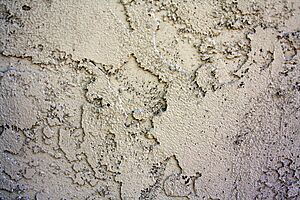Tunnels of San Antonio facts for kids
The tunnels of San Antonio are found in the Luya province in Peru. They are natural rock formations that look like bridges over the San Antonio river.
In 1986, an amazing discovery was made here: ancient cave paintings! An expedition called the Antisuyo expedition, organized by the Amazon Archaeology Institute, found them. These paintings are super important because they are the first real cave paintings ever found in the Amazonian Andes and the Peruvian mountains.
What Makes These Paintings Special?
These aren't just regular rock paintings. They were painted on a wall, not just a rock surface. Also, the way they are drawn is very different from typical rock art. The faces of the people in the paintings look very real, showing a high level of naturalism.
Many experts, like Langlois and Reichlen, had visited the area before but never saw these paintings. This is partly because they were in a hurry. But also, the paintings are only clearly visible at certain times of the day when the sun isn't shining directly on them. Even though experts didn't find them, local people had known about the San Antonio paintings for a long time. The first clues about them came from Carlos Torres Mas and Carlos Gates.
The Antisuyo expedition in 1986 was planning to explore San Antonio very carefully and map out the important ancient buildings. So, they would have found the paintings anyway! The team studied the paintings thoroughly. They traced them, took photos, and recorded videos in both 1986 and 1987.
The Painted Wall
The San Antonio cave paintings are getting old, and time has affected them. But you can still see most of the scene and many details of the main figures. The painting is on a curved wall. The artists mainly used a reddish-brown color called ochre–red. They put this color on a white layer, which was made of rendered material. This white layer covered a carefully smoothed stucco made of yellowish clay.
This painted wall might have originally been a special ceremonial wall shaped like a semicircle. From the parts that are still left, it looks like the wall was more than 4.80 meters (about 15.7 feet) tall and over 9.60 meters (about 31.5 feet) long. The painting covers the entire lower part of the wall horizontally. This means the figures stretch across a surface of 9.60 meters. The figures are all about the same height, between 1.10 and 1.40 meters (about 3.6 to 4.6 feet) tall.
The wall faces some sarcophagi (ancient stone coffins) that are in a hill on the other side of a deep gorge. Some of these sarcophagi have never been touched by people because it's so hard to reach them. It's thought that it's not just a coincidence that the wall was painted facing the rock formation where the sarcophagi were placed.
What the Paintings Show
The painting seems to show a special dance, maybe a ritual or magic dance. There are five pairs of people, men and women, dancing together. Some might argue that the figures don't look like they're moving. They appear to be standing still, facing each other. But a big clue that it's a dance is that the couples are holding hands.
At one end of this scene, there are more figures grouped together. They reach up more than 2 meters (about 6.5 feet). It's hard to tell exactly what these figures are because they are not well-preserved. But you can still see some clear details. This part of the painting doesn't have the same organized arrangement as the main figures. Even though it's less damaged, some parts still have bright colors that haven't faded much over time.
The men in the painting can be recognized by their fancy hairstyles. These hairstyles seem to copy the horns of deer. Some of the women have a hairstyle that looks like ones seen in paintings from another ancient site called Pajatén. Their hair has two slanted parts that some experts think look like symbolic wings. For most of the figures, the bodies and faces are drawn simply, almost like a schematic or outline.
One man's face, especially the one in the second couple from the left, is very well-done. It looks very realistic and expressive. The artist painted this person's face looking slightly to the side, but with the eyes looking straight ahead. This was a very skillful artistic trick, unless it happened by accident! This person's visage can make people feel amazed and surprised because the pupils seem to stare directly at you, as if they are looking into your thoughts.
See also
 In Spanish: Túneles de San Antonio para niños
In Spanish: Túneles de San Antonio para niños


